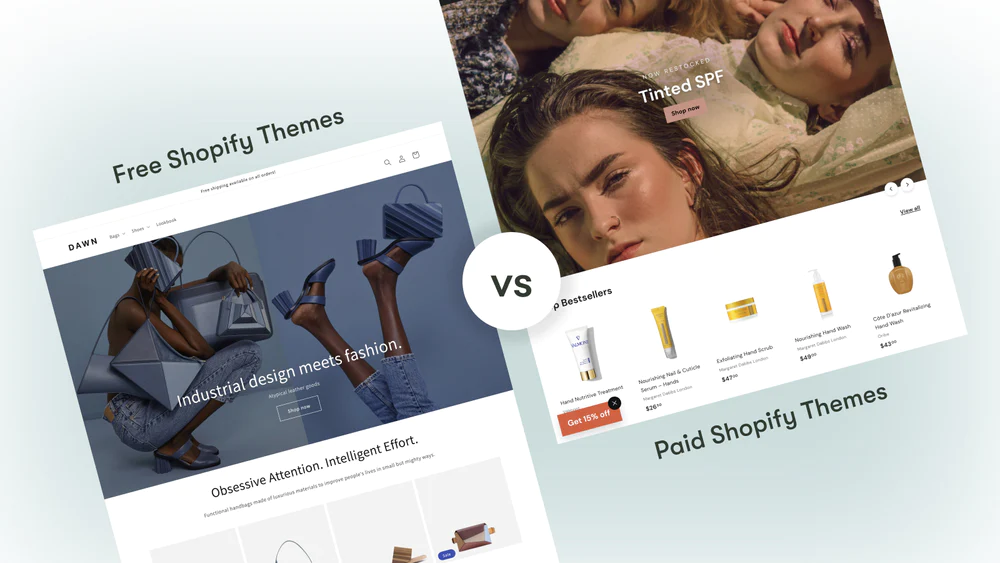The look and feel of your online store is the core ability to attract customers and drive more sales. With the right Shopify theme, you can create an immersive and engaging experience for people visiting your ecommerce site. With hundreds of Shopify themes to choose from, how do you select the perfect one for your business? In this comprehensive guide, we’ll cover:
- Factors to consider when choosing a theme
- The most popular styles of Shopify themes
- Recommended Shopify themes for specific niches
- Comparing paid and free themes
- Personalizing your theme with Shopify sections and apps
Follow along for a step-by-step approach on selecting the ideal theme to power your online store as well as best practices for customizing it to match your brand identity. Let’s dive in!
Key Factors to Consider When Choosing a Shopify Theme
Before starting the Shopify theme search process, it helps to identify how you want the theme to function and what the desired look should be. Here are some key aspects to consider:
Compatibility with Features
The theme needs to support the essential features you want for your store whether it’s blogging, mega menus, advanced product filtering or anything else. Some theme builders support selects add-ons better than others.
Visual Style
Identify the colors, fonts, iconography, layout, and overall visual style you want for your store. Do you prefer minimalist, vibrant, elegant, playful, or retro? Aligning the theme style with your brand style builds recognition.
Performance
The theme needs to load fast on both desktop and mobile to keep visitors engaged. Faster load times leads to lower bounce rates and greater sales conversion. Yet, if you’re not sure what load time would be best for your project look in to hire shopify developers for your guidance. So, pick a lean, optimized theme.
Responsiveness
With most of the traffic from mobile, pick a theme that adapts seamlessly across different device types and screen sizes for easy shopping and navigation.
Ease of Customization
You’ll need to customize the theme over time as your business grows so pick an easy to edit theme that doesn’t require code changes for simple content and design updates.
Popular Kinds of Ecommerce Themes with Examples
There are an endless variety of design styles and specialization areas when choosing between Shopify themes. But most online stores fall into a few common buckets which we’ll explore next with leading examples:
Minimalist Themes
These have lots of negative/white space, a simplistic layout and use typography-focused design. Example: Venture by The4. Boldly Simplistic. Retina Ready.
Vibrant Themes
These use bright colors and playful, attention-grabbing elements across the storefront. Example: Debutify by Good Themes. Super-Fast. Built for Dropshipping. Customizable.
Multi-Purpose Themes
Very versatile for multiple niches. Focus extensively on layout flexibility and feature support. Example: Blueprint by The4. Responsive. Multi-Niche Ready. FOMO Features.
Niche-Specific Themes
Cater to specific types of stores like fashion/apparel, watches, outdoors, books, jewelry, dozen more niches with tailored designs. Example: Narrative – Watches, Accessories & Jewelry Theme. Sophisticated. Modern. Adaptable.
Best Shopify Themes for Top Ecommerce Niches
If you have a niche business model, using a Shopify theme tailored specifically for that industry can make a tremendous difference. Let’s look at top theme recommendations across popular ecommerce niches:
Fashion and Apparel Themes
- Focal (Minimal, clean, bold)
- Brooklyn (Streetwear styling, bold images)
- Moda Operandi (High-end fashion focused)
Beauty Supply and Cosmetics Themes
- Avenue (Sephora-style beauty theme)
- Sampler (Clean beauty boutique look)
- Flawless (Elegant feminine cosmetic theme)
Homewares and Furniture Themes
- Homestead (Rustic, earth tones)
- Express (Midcentury modern furniture shop style)
- Kammok (Outdoors, adventure styling)
Skate/Surf Shop Themes
- West (Distressed, gritty skate shop theme)
- Brooklyn (Streetwear style works great)
- Venture (Minimalist, photo-centric)
While these themes help convey the look and feel of specific niches beautifully, don’t limit yourself strictly to those verticals. Get creative in mixing and matching styles by customizing these themes further with your own branding, content focus and apps.
Paid vs Free Themes – How to Decide
One of the biggest decisions is whether you want to use a paid theme or free theme to power your online store on Shopify. Let’s explore the tradeoffs:
Paid Themes
Pros:
- More polished, premium design options
- Better performance, speed and security
- Superior flexibility for customization
- Ongoing customer support for issues
Cons:
- Expensive (themes can cost $140-$180 on average)
- Significant upfront investment
Free Themes
Pros:
- Completely free to install and use
- Decent variety of styles available
- Allows launching quickly without big spends
Cons:
- Very limited customization options
- More basic, amateurish designs
- Higher risk of bugs and performance issues
- Lack of support channels
Ultimately both routes can work depending on your budget, timeline, design needs and comfort with custom coding. If you have specific requirements around visuals, features and customizability, start with paid themes as they allow realizing your vision without restrictions. They provide more control while looking extremely professional out the box.
Free themes work best for early testing, minimum viable products to validate ideas and young stores that want to launch quickly without big upfront spends. You can always upgrade to paid themes later once traction has been validated.
Personalizing Your Theme with Sections + Apps
To make your Shopify theme feel completely tailored to your brand and products, you’ll need to hire dedicated developers who can customize it significantly beyond the base design. Let’s explore best practices for personalization using two key methods – sections and apps.
Sections
Shopify Section are pre-built blocks that serve specific functions like highlighting products, welcoming first time customers, or showcasing user-generated content. They make adding and editing content simple and visual.
Start by adding a custom Announcement Bar section across the top to showcase discounts or other messages directly. Then create an image slider in the header to highlight seasonal offers. Sprinkles Little Extras sections throughout product pages to suggest gift wrapping and upsells. And load the footer up with more links, newsletter sign ups, testimonials, and badges.
There are endless possibilities to craft bespoke experiences and tell your brand story using 30+ pre-made sections tailored to commerce needs.
Apps
The Shopify App Store houses thousands of third-party apps capable of adding advanced functionality not available out the box in your theme. App integration helps build a tailored solution catering to your exact product mix and workflows.
Apps allow accepting multiple payment modes, setting up advanced shipping rules, adding complex product customization options, building sophisticated reward programs, managing thousands of SKUs, and enabling omnichannel retail capabilities across brick and mortar as well as online store.
Conclusion
Selecting the ideal Shopify theme sets the foundation for your ecommerce brand’s online presence and customer experience. Match the theme’s design style, features and ease of editing capabilities to your specific niche, products, content strategy and customization needs. While paid themes allow realizing more ambitious designs, free themes work great for early testing and validation. Carefully evaluate your budget and business requirements.
Don’t just install a theme and leave it as is! Combine pre-built theme sections with complementary apps to craft a personalized storefront that conveys your brand story and makes the shopping experience highly enjoyable. With the techniques covered in this guide, you now have a solid game plan for identifying and customizing a Shopify theme tailored beautifully to your online shop’s needs.

















Leave a comment